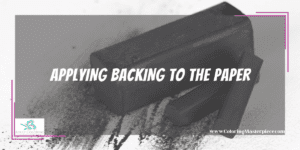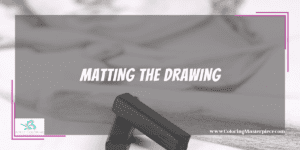Charcoal drawings are a favorite among beginners because of its versatility. Bold lines, smudges, edges that are blended, and soft lines are all possible with an ease of use that isn’t possible with other mediums. But how do you frame a drawing or coloring book page that is drawn in charcoal when the charcoal itself is so malleable?
Applying Backing to the Paper

Backing for an art piece is a section of board or cardboard that you’ll use to affix the charcoal drawing to a more stable surface that won’t bend or crease the page. Artist tape is available for this process at any major art supply retailer. You can also use V and T hinges, which are various ways of using artist tape to attach the charcoal drawing to the backing.
A T hinge is two pieces of tape, one going vertically on the crease between the page and the backing and another crossing the backing horizontally where the top of the paper meets the board. It is called this because it looks like a T when finished.
A V hinge is when a V is made at every corner, of the piece itself, to keep the artwork attached to the backboard. This may look better, but it isn’t as sturdy as a T hinge, so it isn’t recommended for beginners as the probability of making a mistake is high.
The backing you use needs to seal the drawing into the frame so that moisture doesn’t get into the boxed-in area inside of the frame. If moisture gets in, discoloration from mold spores or condensation will ruin your drawing. This can be done by covering the back of the frame with foil or using the artist tape you used to secure the drawing to seal the gap on the back of the frame shut.
Want to know where to find the best coloring supplies for adults?
Using a Fixative
While some artists are against using a fixative for their charcoal drawings, it’s a viable option that needs to be considered. A fixative is a substance you’ll spray over the top of a charcoal drawing to keep the charcoal in place, which prevents smudging or smearing of the charcoal as it is placed under glass.
Before applying a fixative, make sure that all loose pieces or balls of charcoal on the surface of the paper have been removed. Using a fine paintbrush to do this will help you so you don’t smear the charcoal and ruin your coloring page or art piece. You’ll also want to make sure your drawing is on an angled surface when applying the fixative so that it doesn’t pool and become thicker in some spots, which will affect its final appearance.
Use caution when using a fixative. It’s best to create a test page with different strokes on it to see how the fixative will look with the charcoal so you don’t ruin your finished masterpiece. Do not soak the page as the idea is to lightly coat the paper. The saturation of the paper will change the look of your piece and may be a total bummer if it ruins your drawing or coloring book page. Too much fixative can also cause drips to appear, and as the drips run down the page, it will pick up the charcoal particles you’re trying to preserve and smear them down the page.
Once you’ve applied a fixative, make sure it dries overnight to ensure that the fixative itself doesn’t stick, run, or ruin your piece before you’re able to frame it. You’ll also want to make sure you’re using a high-quality fixative that isn’t gummy when dry so that dust and loose hair don’t get stuck to the drawing during the framing process.
Matting the Drawing

A mat is a piece of thick paper, foam, or cardboard that acts like a mini frame inside of the main frame that you are using to enclose the piece. It goes over the top of the drawing, obscuring the sides underneath it so that the glass isn’t touching the actual art and is instead touching the matting inside.
Not only does a mat keep your work from smudging on the glass, but it also helps to centralize a gazer’s eyesight on the drawing itself instead of looking at all the white space around your drawing. Pick a piece of matting that will accentuate your piece instead of overtaking it or hiding it. Keep in mind that matting can be used to hide accidental smudges from your hands or shading utensils that may occur outside of your work. Matting itself is an art and affects how your final piece is interpreted.
It’s vitally important to make sure the piece is matted so the charcoal doesn’t rub up against the glass, so make sure you don’t skip this step! Even if you’ve chosen not to use a fixative, the matting process is not something that can be skipped. You’ll want to double or even triple-layer the matting you use to make sure the glass won’t touch the artwork that’s underneath it.
Conclusion
Because charcoal is such a delicate medium in terms of smudging, major care must be taken during the framing process. When possible, let a professional frame your piece. However, using the techniques above, it is possible to frame your piece at home. Make sure to mat your piece so the glass isn’t touching the drawing itself. Also, make sure that the fixative you use isn’t sticky so stray dust doesn’t affix to the top of your drawing. If you take the proper precautions, your piece can be preserved for years to come.
Maximize the benefits of coloring with my free adult coloring eBook and by signing up for my email newsletter HERE!
Disclaimer: The information provided by ColoringMasterpiece.com (“The Site”) is for general informational purposes only. All information on the Site is provided in good faith, however, we make no representation or warranty of any kind, express or implied, regarding the accuracy, adequacy, validity, reliability, availability, or completeness of any information on the Site. Under no circumstance shall we have any liability to you for any loss or damage of any kind incurred as a result of the use of the Site or Reliance on any information provided on the Site. Your use of the Site and your reliance on any information on the Site is solely at your own risk. This blog post is for educational purposes only and does not constitute legal advice. Please consult a legal expert to address your specific needs.
Terms and Conditions: https://coloringmasterpiece.com/terms-and-conditions/

